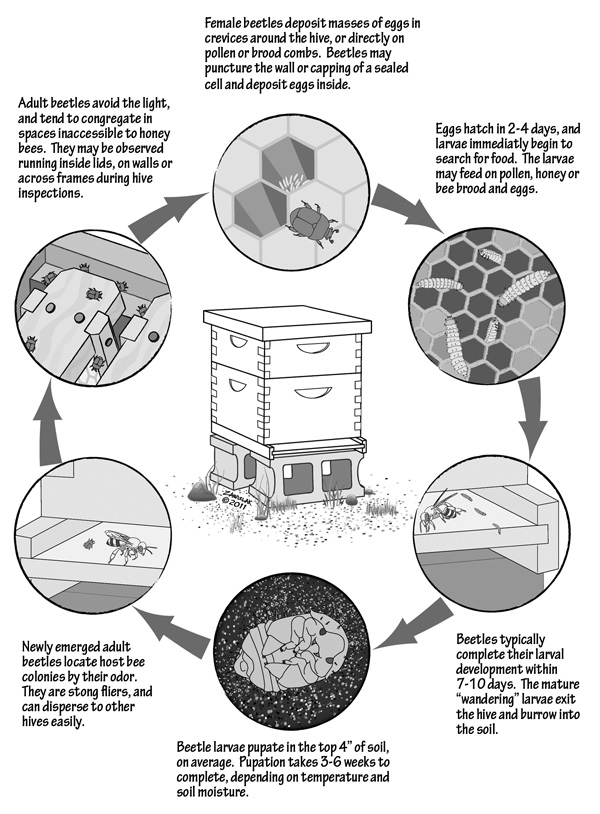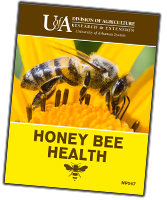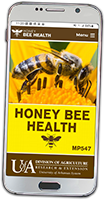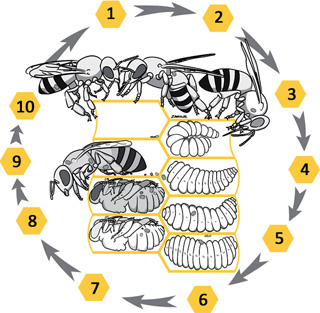Contact
Assistant Professor of Apiculture & Urban Entomology
Phone: 501-671-2222
Fax: 501-671-2252
Email: jzawislak@uada.edu
Web: uaex.uada.edu/bees
University of Arkansas System
Division of Agriculture
Cooperative Extension Service
2301 S. University Avenue
Little Rock, AR 72204
Honey Bee Parasites, Hive Pests, & Bee Diseases
Keeping bee hives healthy is an important component of modern beekeeping. As humans
have moved European honey bees around the world, the bees have come into contact with
exotic diseases, parasites for which they have had little resistance. Unfortunately,
many of these pests have been been accidentally imported into the U.S. and have spread
rapidly across the country. Because beekeepers routinely transport colonies around
the country each year, these maladies continue to circulate through honey bee populations.
Modern beekeeping is challenging, and has a steep initial learning curve. Some level of periodic losses should be expected. Beekeepers should always be vigilant about the condition of their colonies.
|
Varroa Mites are the #1 enemy of honey bee and beekeepers around the world. These external parasites feed on the blood of adult honey bees, and reproduce on honey bee pupae. They can considerably weaken individual bees, and often vector viruses and other pathogens between bees. Mites are spread to other colonies through drifting and robbing. Their high reproductive potential makes managing these mites a considerable challenge for beekeepers. Treatment strategies against varroa mites are numerous and variable, however none are completely effective. Consult the Beekeeping Pesticide and Medication Recommendations for Arkansas (MP-144) for a list of currently registered products. The Honey Bee Health Coalition has an excellent, detailed guide to effective varroa sampling and control. |
|
|
The reproductive cycle of the varroa mite is closely tied to the developmental cycle
of the honey bee. During times of no brood rearing in the colony, varroa mites cannot
reproduce, and remain on the adult bees. (1) While in this phoretic stage, varroa feed on the hemolymph (blood) of adult bees, puncturing the soft intersegmental membrane on the bees abdomen. During the winter, mites can remain on adult bees for many months. While mites can survive on adult bees of any age, they prefer to feed on young nurse bees. (2) A brood pheromone signals nurse bees that a honey bee larva is ready for pupation, generally about 9 days old. Varroa mites also detect this cue and use it to locate suitable hosts as worker bees go from cell to cell tending the brood. (3) The foundress (a mated reproductive female mite) hides in the food provisions in the brood cell while worker bees seal the larva inside with a thin wax capping. (4) Safely sealed inside the pupal cell, the foundress emerges and begins to feed on the hemolymph of the larva. (5) Approximately 60 hours after the cell is sealed, the foundress will lay her first egg, which will become a male. Each additional egg, laid about every 30 hours, will become a female. (6) As varroa mite nymphs emerge, they will feed on the bee pupa, grow and molt over several days. Male varroa mites mature in 5-6 days; females in 7-8 days. (7) The male mite is fully developed by the time its first sister reaches maturity. The pair will alternate between periods of feeding and mating. As each female mite matures, the male will mate with her as often as possible until another female matures or the adult bee emerges from its cell. (8) When the bee reaches maturity, it chews a hole in the capping and exits, releasing the foundress and her mature female offspring. The number of mature offspring is limited by the duration of the bees pupal development. Therefore mites reproducing in drone cells have greater reproductive potential than those reproducing in worker cells. (9) The male varroa mite and all immature females will never leave the cell. They quickly die and are removed by housecleaning bees, preparing the cells for the queen to deposit new eggs. (10) As mites exit a cell with the newly emerged bee, they usually move onto a host bees, where they will remain phoretic for several for days, occasionally feeding and changing hosts again. Soon mites will seek a suitable host on which to complete their reproductive phase. By remaining on nurse bees, varroa have easy access to suitable larvae. During times of brood rearing, mites will spend most of their time inside the pupal cells, where they are difficult to kill. The phoretic stage is the most vulnerable point in the mites' life cycle. Therefore most treatments for varroa mites are most effective during times of no brood rearing. |
Tracheal Mites (Acarapis woodii) are internal parasites of honey bees. They live and breed inside the tracheal tubes which insects use to breathe. Bad infestations can negatively impact colony health, but because of their microscopic size, tracheal mites have been largely overlooked by most beekeepers. Increased selection pressure has improved the honey bees' natural resistance to this pest. Additionally, many of the current in-hive fumigants used against varroa mites also control tracheal mites.
The small hive beetle Aethina tumida (SHB) is an invasive pest of bee hives, originally from sub-Saharan Africa. These beetles inhabit almost all honey bee colonies in their native range, but they do little damage there and are rarely considered a serious hive pest. How this pest found its way into the U.S. is unknown, but it was first discovered to be damaging honey bee colonies in Florida in 1998. It has since spread to more than 30 states, being particularly prevalent in the Southeast. The beetles have likely been transported with package bees and by migratory beekeepers, but the adult beetles are strong fliers and are capable of traveling several miles at a time on their own.
In Arkansas the beetles are usually considered to be a secondary or opportunistic pest, only causing excessive damage after bee colonies have already become stressed or weakened by other factors. Infestations of beetles can put significant stress on bee colonies, which can be compounded by the stress of varroa mites and other conditions. If large populations of beetles are allowed to build up, even strong colonies can be overwhelmed in a short time. Honey bee colonies appear able to contend with fairly large populations of adult beetles with little effect. However, large beetle populations are able to lay enormous numbers of eggs. These eggs develop quickly and result in rapid destruction of unprotected combs in a short time. There is no established threshold number for small hive beetles, as their ability to devastate a bee colony is related to many factors of colony strength and overall health. By maintaining strong bee colonies and keeping adult beetle populations low, beekeepers can suppress the beetles' reproductive potential.

For more information consult Managing Small Hive Beetles (FSA-7075).
The Greater Wax Moth (Galleria mellonella) is another opportunistic pest found in honey bee hives, and cause significant damage to stored combs. The best defense against wax moths in the hive is to keep colonies strong and healthy. Once surplus combs are removed from a hive, they should be protected from wax moths until the first hard freeze of the fall season. Combs can be protected by fumigating them, or storing them where they have plenty of sunlight and air circulation. Consult the Beekeeping Pesticide and Medication Recommendations for Arkansas (MP-144) for a list of currently registered fumigation products.
Honey Bee Diseases
For a detailed and illustrated reference on honey bee diseases, see MP 547.
American Foulbrood is a highly lethal and contagious disease of honey bees, caused by the spore-forming bacteria Bacillus larvae. The disease causes larvae to die after cells are capped. Worker bees have difficulty trying to remove the dead larvae, and often contaminate the hive with additional spores. As the colony weakens and dies out, bees from other colonies (sometimes from several miles away) will be apt to rob out the remaining honey. As they travel through the hive, they become contaminated as well, and introduce the bacterial spores to their colony as well. Antibiotics do not kill this bacteria or prevent the disease, but merely hold it off temporarily. Colonies known to be infected with American Foulbrood must be destroyed by burning to prevent the disease from spreading to a other hives and other nearby apiaries. Beekeepers who suspect that a hive may contain AFB should contact their state apiary inspectors immediately. Failure to do so could put all of their hives at risk, as well as those of others in the vicinity. AFB is not harmful to humans or any other creature besides honey bees. Visit MAARC for photos and more information.
European Foulbrood is another bacterial disease, although slightly less contagious that AFB. If diagnosed at an early stage, a colony can recover from a mild infection of EFB. Beekeepers are advised to consult and follow the advice of their state apiary inspectors. European foulbrood disease can be treated with appropriately used antibiotics. Recent changes in federal law require that animal antibiotics (including those for honey bees) can only be obtained with a valid veterinary feed directive (similar to a prescription). To find veterinarians willing to inspect and treat honey bees, download the most current Arkansas Veterinary Directory.
Nosema is a condition caused by the microsporidia Nosema apis or Nosema cerana. This microbe attacks the cells in the wall of a honey bee's stomach, where it reproduces and attacks repeatedly, eventually destroying the stomach lining. This cycle of infection takes some time to build up, during which the bee is increasingly unable to digest food. As a result, the bees become weaker and their hind-guts fill with fecal material. Nosema disease has traditionally been associated with long-lived overwintering bees, confined in the hive for extended periods of time. If unable to take periodic cleansing flights (due to cold weather), severe dysentery symptoms may become apparent in the hive and around the entrance. Housecleaning activities of healthy bees often cause them to ingest spores, initiating their infection. Typically the disease disappears once spring weather allows for regular cleansing flights and spring pollen plants induce increased brood rearing. However, new strains appear to be more virulent, and may attack a colony during any time of year, especially if the colony health has been compromised by pesticide exposure or other factors. Treatment for nosema includes feeding colonies syrup medicated with Fumigillin.
Chalkbrood is a brood disease caused by the fungus Ascophaera apis. Beekeepers typically notice the condition in early spring when workers remove and discard infected larvae near the entrance of the hive. There is no medical cure for chalkbrood disease, but it is rarely serious to the colony. As spring brood rearing increases, a colony typically out-grows the condition. If it persists year after year in the same colonies, beekeepers should discard the combs and sterilize woodenware before installing new foundation.
Sacbrood Virus affects only the honey bee larvae, and is mildly contagious within the hive. Typically, the disease can be stopped by requeening a colony. The break in the brood cycle allows worker bees to remove all infected larvae during an interval when no additional larvae of a susceptible age are present. There is no medical treatment for sacbrood.
Other Honey Bee Viruses are commonplace today. There are many viruses that negatively affect honey bees (around 30 currently known). Some, such as Deformed Wing Virus produce visible symptoms, but most do not. Viruses are mainly vectored between bees and colonies by parasitic mites.
There is currently no medical treatment for bee viruses. But effectively managing mite populations can greatly reduce the impact of bee viruses.
Hard Times for Honey Bees: Colony Collapse Disorder
Honey bees are the world's best known pollinators. These industrious insects are estimated to add more than $15 billion in increased crop yields in the U.S. each year. There are around 20,000 species of bees in the world, and nearly 4000 species native to North America, but the European honey bee, Apis Mellifera, performs more than 80 percent of pollination on most of our commercial crops. Approximately one third of our diet is directly or indirectly dependent on bee pollination. This includes the obvious fruits and vegetables, as well as many nuts, oil-seed crops, herbs and spices, and much of the forage that is needed for the beef and dairy industries. In addition, bees pollinate a number of non-crop plants that are vital to wildlife and to the propagation of the plants themselves. The California almond crop alone requires 1.3 million colonies of bees each year - approximately half of our Nation's managed honey bees - which must be transported into the growing area each spring.
A dramatic decrease in feral honey bee populations began in the 1980s, with the accidental importation of two parasitic mite species. Since then, the increasing costs associated with managing honey bees with these mites and other hive pests, combined with depressed honey prices caused by cheap imported honey, has caused many beekeepers to quit the industry. Since the 1940s the number of managed bee colonies in the U.S. has declined from over 5 million to about 2.5 million. With feral bee populations effectively decimated, the need for mobile pollination services has increased. The current situation affecting managed bees may result in a pollinator shortage that could become a crisis for agricultural production.
Beginning in the winter of 2006, beekeepers across the U.S. reported losses of 50 to 90 percent of their colonies. In many cases the hives had appeared healthy and active within a few weeks of colony failure. Colonies that survived this situation often had populations too small to provide effective pollination or honey production. Losses of overwintering colonies are not unknown, but at least half of these colony deaths exhibited symptoms inconsistent with those of parasitic mites or other known diseases. Because the cause of death was undetermined, the term "Colony Collapse Disorder" (or CCD) was used to describe the situation.
CCD may not be a new and distinct phenomenon. Large-scale bee die-offs have periodically occurred in the past. Older literature describes these situations as spring dwindle disease, fall dwindle, or autumn collapse. In 1975, a situation termed Disappearing Disease affected a large number of bee colonies in the U.S. It may probably never be determined if these historic situations share a common cause with the current crisis. In the current situation the bee populations do not dwindle, implying a slow death over time, but the adult population effectively disappears suddenly, within a few weeks or days. Also the term disease implies a pathogen is responsible for the condition, which is something unknown at this point. Therefore, Colony Collapse Disorder is a more appropriate term for the recent phenomenon.
Common symptoms of CCD include: (1) a sudden loss of the colony's adult bee population; (2) very few dead bees present in or around the hive; (3) the presence of a healthy laying queen bee with a small cluster of newly-emerged attending workers; (4) frames of healthy, capped brood with low levels of parasitic mites, indicating that the colony was recently vigorous and healthy; (5) substantial food reserves of pollen and honey, which are not readily robbed by other active colonies in the vicinity; (6) minimal evidence of invasion by wax moths, small hive beetles, or other opportunistic hive pests. In colonies that are actively collapsing, the number of worker bees is insufficient to maintain the amount of brood present, and the workforce that is present is composed entirely of younger bees.
Because few dead bees remain in or around the affected hives, studying the cause associated with CCD has been difficult. By all appearances, the adult worker bee population simply leaves the hive and does not return. Surveys have been designed to determine what variables the affected colonies may have had in common, but much of this data is based on anecdotal reports provided by beekeepers. Presently, many thousands of U.S. bee colonies have died in the past few years, expressing at least some of the symptoms of CCD. The phenomenon has been reported by apiary inspectors in 35 states, including Arkansas. Clearly, honey bees across the nation are disappearing, but a single definitive cause has yet to be determined. Many potential causes have been suggested. Some of the plausible theories include:
Historic honey bee diseases: These include American foulbrood, European foulbrood, chalkbrood, Nosema, and approximately 30 known viruses. In some locations, strains of foulbrood have been become resistant to the antibiotics traditionally used for their control. While any of these pathogens are potential factors in honey bee decline, none of them, alone or in known combination, produce the symptoms associated with CCD.
Exotic or previously unknown bee diseases: World commerce and the shipment of agricultural and apicultural stocks around the globe have resulted in the introduction of numerous diseases and invasive pest species in the past. It is highly probable that exotic species will continue to enter the country accidentally. Further investigation may reveal the presence of a previously unknown pathogen present in CCD-affected bees.
Arthropod parasites of bees: These include the mites Varroa destructor and Acarapis woodii, both of which are blood-feeders and are potential vectors of honey bee pathogens. They can also be responsible for bacterial infections caused by breaching the integument of the bee. The symptoms associated with the mites themselves do not reflect those of CCD, but they can likely be responsible for depressing general bee immune health, making the bees more susceptible to other maladies.
Queen bee genetics: A relatively small number (in the hundreds) of breeder queens are used in the U.S. to supply the millions of queen bees produced. This lack of genetic diversity may have increased susceptibility to imported or exotic pathogens. Additionally, feral populations that once thrived in the wild through natural selection were effectively eliminated by parasitic mites, and no longer contribute substantial genetic variability to the managed bee populations.
Chemicals used in bee hives: While previously opposed to the use of chemical pesticides around their bees, beekeepers have come to accept and largely depend upon chemicals to combat parasitic mites and other hive pests in order to maintain their colonies. Investigations have found negative sub-lethal effects on honey bee health associated with these chemicals, even when used in accordance with their labels. Many of these chemicals accumulate in the beeswax combs, and long-term exposure to them may be a key factor in the CCD mystery.
Chemicals in the environment: While foraging for food, honey bees are exposed to numerous toxic substances. Investigations have shown that residues and breakdown products from agricultural and household pesticides, and from other sources of pollution, have been introduced to the hive. Neonicotinoids, a relatively new, put highly prevalent, class of chemical insecticides, are highly toxic to bees, and can cause behavioral changes to bees at sub-lethal doses. The non-target effects of these chemicals could be considered as a potential factor in CCD.
Honey bee nutrition: Studies have indicated that honey bee larvae develop best when fed a diet of pollen from diverse plant sources. Forcing bees to forage in monocrop agriculture systems allows little variety in their diets. Additionally, where herbicide-resistant crops are grown, both the crop field and its borders are kept free of flowering weeds, further reducing the nutritional value of the land for bees and other beneficial insects. Feeding bees a winter diet of high-fructose corn syrup by some beekeepers, followed by soy-based pollen substitutes to initiate brood rearing early in the spring, has been suggested to affect the overall health of the bees. However, the methods of providing bees with winter food vary significantly among beekeepers, and no clear correlation has been made to link this practice with CCD.
Apicultural management practices: The ways in which bee colonies are maintained (for honey production, pollination, queen or package bee production, etc.) and how they are routinely handled varies considerably among beekeepers, and cannot be clearly linked to CCD. However, poor management practices, as in any system, can render a bad situation worse.
Because no clear cause (either a single factor or a combination of factors) for CCD has been established and demonstrated experimentally, a treatment for CCD is not currently possible. Many potential causes are currently being investigated. Members of the CCD Working Group, composed of academic, commercial, and government scientists, initiated the first efforts to determine the cause of CCD. Additional federal and state agencies, university researchers, and private institutions have also begun to participate in various aspects of these investigations. Different groups or researchers have focused on determining specifically which, if any, of these above factors can be associated with CCD, individually or in combination. Research efforts have generally involved two components:
Surveys and data collection: A number of surveys have been initiated to determine the extent of CCD and associate the various management practices and conditions under which bees are kept. But these surveys have been too limited in scope or flawed in design to generate accurate statistics. Additionally, the lack of dead bees in collapsed colonies has made the diagnosis of pathogens difficult or impossible to identify. Regular sampling of honey bees from apparently healthy colonies, which are preserved for later diagnosis, may be useful for evaluation if sudden declines are seen in these same populations.
Analysis of sampling: Samples of honey bees, bee parasites and hive products (wax, honey, propolis, and pollen) are currently being analyzed by different groups for the presence of disease-causing organisms, viruses, parasites, and chemical contaminates. Additionally, molecular and genetic analysis of the bees and pathogens is being conducted. Genetic markers for disease-resistance in honey bees are being sought for use in breeding programs. Methods for rapidly determining the presence of pathogens are also being developed. Factors affecting honey bee health are also being quantified by measuring the levels of stress-induced proteins.
Currently, little can be stated decisively on the causes of this phenomenon. For now attempts to effectively prevent colony losses can only be based on improving the overall health of honey bees and their foraging habitat, and reducing known sources of bee stress and mortality. Beekeepers should keep colonies strong by using best-management practices that include common sense:
- Combining collapsing colonies with healthy ones should be avoided
- Equipment from collapsed colonies should not be re-used without adequate sterilization
- IPM should be used to reduce dependence on in-hive chemicals as well as reduce the levels of pesticide exposure that bees contact while outside the hive
- Breeding programs should be pursued to produce hybrid bee stocks resistant to mite parasites and other diseases
- Research conducted to establish best-management practices should be made available and disseminated easily through regional, state, and local beekeeping networks
For further reading, see the current USDA research on Colony Collapse Disorder.


